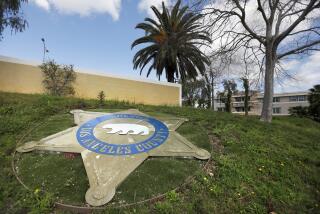Gang Members Out of Sight Since Injunction
- Share via
Several months ago, the southeast gate to the San Fernando Gardens housing project in Pacoima was swarming with gang members.
The so-called Pacoima Project Boys, bragging that they were untouchable, blatantly ignored a gang injunction that made it illegal for them to be seen together.
Since then, because of police warnings and more than a dozen arrests, fewer gang members have been seen hanging out together, residents and Los Angeles police say.
Capt. Kris Pitcher of the Foothill Division said family, traffic and business disputes--and not gang activity--are responsible for the rise in assaults in the neighborhood.
“My gang unit has reported that Project Boys activity has been rather light, and we don’t run into a lot of them anymore,” he said. “We have a gang problem, but the injunction is working.”
Like other gang injunctions, the court order issued against the Pacoima Project Boys on Aug. 22, 2001, made it a misdemeanor for any two gang members to associate in a “safety zone” bordered by Paxton Street on the north, Glenoaks Boulevard on the east, Pierce Street on the south and San Fernando Road on the west. Violators face up to six months in jail.
Deputy City Atty. Jim McDougal said the Los Angeles Police Department targeted the Project Boys because they have been one of the San Fernando Valley’s most violent gangs over the last decade.
“Injunctions work. I’m not sure why they work, but they do,” he said. “It’s strange how gangsters who commit felonies day in and day out will obey a court order.”
Residents and authorities acknowledge that gang members still gather at times--getting together at night or during the day by keeping a watch out for officers. But residents feel safer because there are fewer gang members around to harass them.
That feeling persists even though as of June 17, there were 63 aggravated assaults in the area covered by the injunction, compared with 68 for all of 2001, according to LAPD statistics.
U.S. Postal Service letter carrier Lisa Castillo said the San Fernando Gardens mail route she began earlier this year has not been anywhere near as troublesome as she thought it would be.
“I’ve had no problem at all and I never even see those gang members everyone was talking about,” Castillo said.
A 20-year resident of the projects who, leery of retaliation, asked not to be identified, agreed.
“You just don’t see them anymore,” he said. “There used to be a whole gang of them.”
A block away, at David M. Gonzalez Park, a few gang members were lounging and playing handball, in violation of the injunction. Two of them said the park serves as a good observation post to spot police and run, because “we are too fast for them.”
Outside the park, a heavily tattooed member of the Pacoima Project Boys rode by on his bicycle. He said he was jailed for violating the injunction and the terms of his probation by associating with known gang members in September.
“I don’t bang no more,” said the 25-year-old man, who would not give his name. “I don’t even want the police to see me alone. I’m going back to the projects where I belong.”
Since it began, 13 members of the gang have been arrested for violating the injunction, Pitcher said.
A UCLA professor who has studied more than 20 gang injunctions in Los Angeles County since 1993 said he believes they help reduce crime.
“The year after these things are imposed, we usually see a 5% to 10% reduction in violent crime without any increase in the adjoining area,” said Jeffrey Grogger, a professor at UCLA’s School of Public Policy. “Obviously, 5% to 10% is not putting an end to crime, but these injunctions at least can decrease it.”
Although some people worry about the civil liberties of gang members, courts have ruled that injunctions are constitutional, he said.
“One of the criticisms raised is they provide police a license to crack down not only on gang members but anyone who looks like a gang member,” Grogger said.
Police generally praised injunctions.
“They are a tremendous assist,” said Lt. Gary Nanson, head of the LAPD’s gang unit in the Valley. “It takes a while to get going, but once they do, the gangs go undercover. You just don’t see them anymore.”
More to Read
Sign up for Essential California
The most important California stories and recommendations in your inbox every morning.
You may occasionally receive promotional content from the Los Angeles Times.













